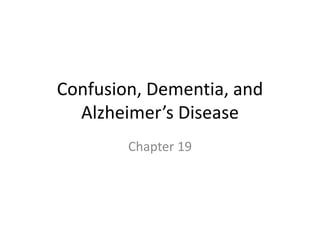Chapter 19: Confusion, Dementia, and Alzheimer’s Disease
Normal aging can include some cognitive decline such as slower thinking and minor memory loss, but confusion, delirium, dementia, and Alzheimer's disease are not normal parts of aging. Confusion can be caused by medical issues like infection or lack of sleep, while delirium involves a sudden onset of severe confusion that may be drug-related. Dementia involves a progressive loss of mental abilities and Alzheimer's disease is the most common cause of dementia in the elderly. Alzheimer's has no known cure and progresses through stages of increasing memory loss and dependence. When caring for those with cognitive issues, it is important to communicate calmly, provide a routine, and not take behaviors personally as the disease impacts their thoughts and actions.

Empfohlen
Empfohlen
Weitere ähnliche Inhalte
Was ist angesagt?
Was ist angesagt? (20)
Ähnlich wie Chapter 19: Confusion, Dementia, and Alzheimer’s Disease
Ähnlich wie Chapter 19: Confusion, Dementia, and Alzheimer’s Disease (20)
Mehr von MarleneDJ
Mehr von MarleneDJ (20)
Kürzlich hochgeladen
Kürzlich hochgeladen (20)
Chapter 19: Confusion, Dementia, and Alzheimer’s Disease
- 1. Confusion, Dementia, and Alzheimer’s Disease Chapter 19
- 2. Normal Changes of Aging • Cognitive decline or impairment – Slower thinking – Some memory loss of recent events • Slower reaction time • Difficulty finding right words • Sleeping less
- 3. Confusion • Inability to think clearly • Causes: – Hospital admit – Dehydration – Infection – Brain tumor – Loss of sleep
- 4. What to do… • Stay calm • Speak in low, calm voice • Introduce yourself each time you see resident • Explain what you are doing • Call resident by name • Report observations to nurse
- 5. Delirium • Severe state of sudden confusion – Usually temporary – May be related to drugs or alcohol – Infection – Electrolyte imbalance in blood (low sodium, potassium, etc) – Disease states
- 6. Symptoms of Delirium • Agitation • Depression • Trouble focusing • Decrease in short-term memory • Poor nutrition • Report these signs to the nurse
- 7. Dementia • NOT a normal part of aging • Loss of mental abilities – Thinking, remembering, communicating • It is progressive… • And degenerative…
- 8. Alzheimer’s disease • Most common cause of Dementia in elderly • Again…NOT a normal part of aging • 1 in 8 people over age 65 has AD • Progressive, degenerative, irreversible • Cause unknown, no cure
- 9. 3 stages • Stage 1 – STM loss – Not oriented to time – Can’t concentrate – Mood swings – Poor judgment – Poor personal hygiene
- 10. Stage 2 • May forget family/friends • Lost ability to perform ADLs • Wandering • Obsessive behavior • Sundowning (restlessness, agitation) • Sleep problems • Incontinence
- 11. Stage 3 • Total dependence on others for care • Apathy • Total incontinence • Does not recognize family or self • Swallowing problems • Coma • Death
- 12. What to do… • Do not take things personally… • Put yourself in their shoes • Work with the visible behaviors for that day • Teamwork • Take care of yourself – Very stressful caring for Alzheimer’s patient • Work with the family…can be a resource
- 13. Communication strategies • Always approach from the front • Don’t get too close, at first • Promote calm environment when trying to communicate • Identify yourself, call resident by name • Speak slowly, low tones
- 14. Strategies (continued) • Use simple words, short sentences • When explaining procedure, list one step at a time • Do not hurry • Repeat yourself, use same words • Use verbal and non-verbal communication techniques…combine pics with words
- 15. More strategies • Listen!! • If bad language, try redirection • Approach, touching slowly • Do not take things personally…it’s the disease speaking
- 16. Assisting with personal care • Establish a routine • Take care of yourself • Promote self-care in resident
- 17. Incontinence • Regular toileting • Signs/pictures on bathroom door • Encourage fluids • Put lids on trashcans to discourage bad habits
- 18. Bathing • Plan bath when resident least agitated • Encourage participation in bathing • Be calm and reassuring • Be sensitive to fears and concerns • Be safe…non-slip tub mats, etc • Check skin during this time
- 19. Dressing • Show clothing • Give just a few choices • Lay out clothes in order of application • Friendly, calm voice • Give praise and encouragement
- 20. Meal time • At risk for malnutrition • Have meals at regular times…routine helps • Simple tasks • Finger foods • White plate…less complicated • Put spoon to mouth to encourage eating
- 21. Behavior interventions Agitation Remover triggers Use slow, soothing tone Stay calm Sundowning Remove triggers Distraction
- 22. Behaviors (continued) • Violent behavior – Hitting • Remove triggers • Block blows but never hit back • Keep safe distance • Pacing/Wandering • Some causes – Needs to go to bathroom – Hunger, thirst, disorientation
- 23. Behaviors (continued) • Perseverating – Answer questions the same, each time – Have patience • Disruptive behavior – Try and find out why – Be calm and friendly – Tell resident about any changes – Do not treat as a child – Dignity and Respect always!
- 24. More… • Pillaging • Hoarding • Validating – No reorienting – Enter into that person’s reality – This is a change in treatment thinking